by Michael Cropper | Mar 23, 2016 | Developer, Security, Technical, Thoughts |
If it ain’t broke, don’t fix it, right? Wrong. This is the belief system of inexperienced software developers and businesses owners who are, in some cases rightfully so, worried about what problems any changes may cause. The reality though is that as a business owners, development manager or other, you need to make sure every aspect of software you are running is up to date at all times. Any outdated technologies in use can cause problems, likely have known vulnerabilities and security issues and will ultimately result in a situation whereby you are afraid of making any changes for fear of the entire system imploding on itself.
Ok, now I’ve got that out of the way, I assume you are now also of the belief system that all software needs to be kept up to date at all times without exception. If you are not convinced, then as a developer you need to come to terms with this quickly, or as a business owner you have not been in a situation yet which has resulted in a laissez-faire attitude to software updates costing you tens of thousands of pounds to remedy, much more expensive than pro-active updates and regular maintenance.
The biggest challenge software developers face at the coal face of the build process is the inherent unpredictability of software development. As a business owner or user of a software application, whether that is an online portal of some form, a web application, a mobile app, a website or something in between, what you see as a user is the absolute tip of the iceberg, the icing on the cake and this can paint completely false pictures about the underlying technology.
Anyone who has heard me speak on software development and technologies in the past will have no doubt heard my usual passionate exchange of words along the lines of using the right technology, investing seriously and stop trying to scrimp on costs. The reason I am always talking to businesses about this is not as part of a sales process designed to fleece someone of their hard earned money. No. The reason I talk passionately about this is because when businesses take on board the advice, this saves them a significant amount of money in the long run.
To build leading software products that your business relies on for revenue you need to be using the best underlying technology possible. And here lies the challenge. Any software product or online platform is built using a plethora of individual technologies that are working together seamlessly – at least in well-built systems. Below is just a very small sample of the individual technologies, frameworks, methodologies and systems that are often working together in the background to make a software product function as you experience as the end user.

What this means though is that when something goes wrong, this often starts a chain reaction which impacts the entire system. This is the point when a user often likes to point out that “It doesn’t work” or “This {insert feature here} is broke”. And the reason something doesn’t work is often related to either a poor choice of technology in the first place or some form of incompatibility or conflict between different technologies.
To put this into a metaphor that is easier to digest, imagine an Olympic relay team. Now instead of having 4 people in this team, there were 30-50 people in this team. The team in this analogy is the software with the individual people being the pieces of software and technologies that make the software work. Now picture this. An outdated piece of technology as part of the team is the equivalent of having an athlete from 20 years ago who was once top of their game, but hasn’t trained in the last 20 years. They have put on a lot of weight, their fitness level is virtually zero and they can’t integrate as part of the team and generally have no idea what they should be doing. This is the same thing that happens with technologies. Ask yourself the question, would you really want this person as part of the team if you were relying on them to make your team the winning team at the Olympics? The answer is no. The same applies with software development.
Now to take the analogy one step further. Imagine that every member of the relay team is at a completely different level of fitness and experience. Each member of the team is interacting with different parts of the system, but often not all of the system at once. What this means is that when one of the athletes decides to seriously up their game and improve their performance, i.e. a piece of technology gets updated as part of the system, then this impacts other parts of the system in different ways. The reality of software development is that nothing is as linear as a relay team where person 1 passes the baton to person 2 and so on. The reality of software development is that often various pieces of technology will impact on many other pieces of technology and vice versa and often in a way that you cannot predict until an issue crops up.
So bringing this analogy back to software development in the real world. What this means is that when a new update comes out, for example, an update to the core Apple iOS operating system, for which all mobile applications rely on, then this update can cause problems if a key piece of technology is no longer supported for whatever reason. This seemingly small update from version 9.0 to 9.2 for example could actually result in a catastrophic failure which needs to be rectified for the mobile application to continue to work.
Here lies the challenge. As a business owner, IT manager or software developer, you have a choice. To update or not to update. To update leads you down the path of short term pain and costs to enhance the application with the long term benefits of a completely up to date piece of software. To hold off on updating leads you down the path of short term gain of not having to update anything with the long term implications being that over time as more and more technologies are updated your application is getting left in the digital dark ages, meaning that what would have been a simple upgrade previously has now resulted in a situation whereby a full or major rebuild of the application is the only way to go forward to bring the application back into the modern world. Remember the film Demolition Man with Wesley Snipes and Sylvester Stallone, when they stayed frozen in time for 36 years and how much the world had changed around them? If you haven’t seen the film, go and watch the 1993 classic, it will be a well spent 1 hr 55 mins of your time.
The number of interconnecting pieces powering any software product in the background is enormous and without serious planned maintenance and improvements things will start to go wrong, seemingly randomly, but in fact being caused by some form of automatic update somewhere along the lines. Just imagine a children’s playground at school if this was left unattended for 12 months with no form of teacher around to keep everything under control. The results would be utter chaos within no time. This is your software project. As a business owner, IT manager or software developer you need a conductor behind your software projects to ensure they are continually maintained and continue to function as you expect. It is a system and just like all systems of nature, they tend to prefer to eventually lead towards a system of chaos rather than order. There is a special branch of mathematics called Chaos Theory which talks about this in great depth should you wish to read into the topic.
As a final summary about the inherent unpredictability of software development. Everything needs to be kept up to date and a continual improvement process and development plan is essential that your software doesn’t get left behind. A stagnant software product in an ever changing digital world soon becomes out of date and needs a significant overhaul. What this does also lead to is the highly unpredictable topic of timelines and deliverables when dealing with so many unknown, unplanned and unpredictable changes that will be required as a continual series of improvements are worked through. What I can say is that any form of continual improvement is always far better than sitting back and leaving a system to work away. For any business owner who is reading this, when a software project is delayed, this is generally why. The world of software development is an ever moving and unpredictable goal post which requires your understanding. Good things come to those who wait.
by Michael Cropper | Aug 14, 2015 | Thoughts |
Today I want you to have a think about your organisation and its suppliers in general, digital or otherwise. And ask yourself the question; are your suppliers costing you money or adding value to your business?
Naturally with speaking with a lot of businesses we hear a lot of information and comments about costs, investments, pricing information and a lot of other information that enables us to get a good feel for how a business perceives different items within their business and supply chain. There is an excellent book titled The Slight Edge by Jeff Olson, which if you haven’t read I’d urge you to go out and buy a copy now. The book can really be summarised by the image below;
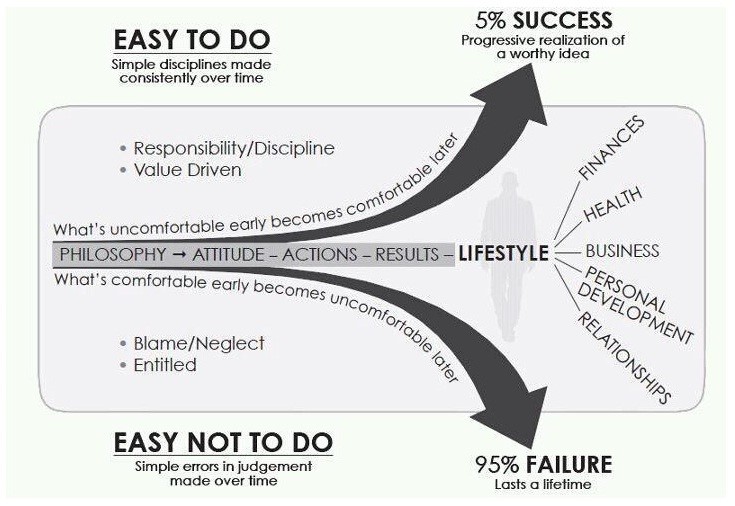
Source: http://slightedgecommunity.com/blogs/12726/3614/beyond-the-12-steps-the-slight
And summarised further by a quote from Yoda in Star Wars;
“No. Try not. Do… or do not. There is no try.” – Yoda
The same is true in business. You either make the right decision, or the wrong decision, there is no middle ground. Many businesses often make the wrong decisions when it comes to their digital assets, but we’ve already talked about that quite a bit recently. Here I want you to take a bit of time and think about your business in a slightly different way than you do currently. Think critically about where you are now, where you want to get to and if the decisions that are being made are working towards these goals or away from them. As Yoda said, there is no try, you are either making strategic decisions daily which are working towards your goals or you are naturally moving away from your goals either by doing nothing or making the wrong decisions.
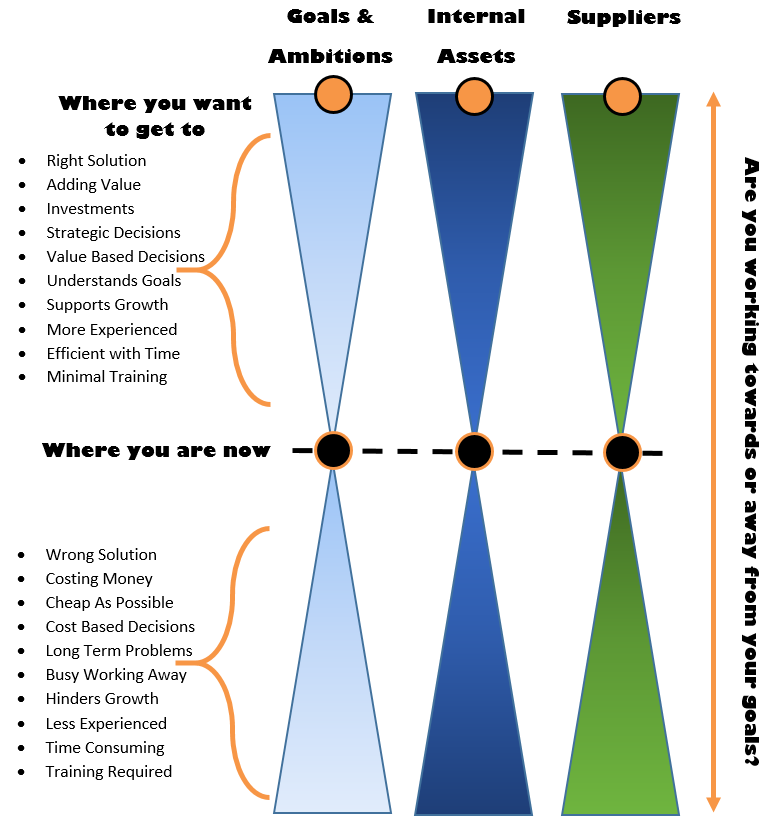
Markets are changing at a faster pace than ever before and as a business it is essential that you keep up to date with these changes to compete. There is an enormous cost of doing nothing within business as competitors are continually improving and markets are ever shifting. We’re not talking about significant innovation within your business, although this is absolutely essential and a topic for a future blog post, no, where talking about incremental improvements based on making strategic decisions that are going to move your business forward.
To put this into perspective, below are a few graphs showing the cost of doing nothing compared to the results of making the right decisions. The top graphs show a 5% decline year on year based on an ever more competitive market place, which you have failed to keep up with, and the bottom graph showing a 5% increase year on year based on making the right strategic decisions. The data is clear;
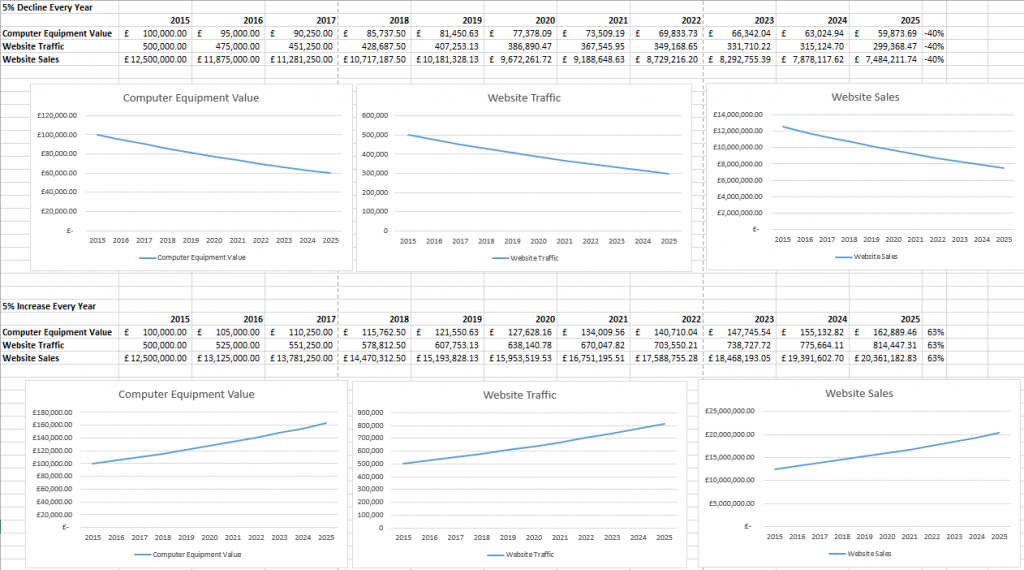
(click for larger graphs)
Remember, you are either actively improving your business in all aspects or you are falling behind. There is no middle ground of staying steady. Take some time and have a think about your business in a critical way for every aspect. And remember, we always have time for a coffee if you want to bounce a few ideas off us, we’re a friendly bunch and will always give you honest feedback and comments about your digital and technology choices whether this is what you want to hear or not. We like to work with businesses and help them along their journey to their goals and ambitions.
by Michael Cropper | Jul 1, 2015 | Digital Marketing, Thoughts, Tracking |
Why is it that so many businesses still see a website as a cost rather than an investment to generate a return? We live in a digital world so why isn’t your online presence at the forefront of your business strategy to increase revenue? Well, after speaking with thousands of businesses ranging from startups all the way up to companies with offices around the globe, I’ve noticed a few common comments and it’s time to debunk some of the common reasons we hear and get serious about your investments in digital channels.
The Current Situation
So many established businesses will happily spend money on traditional activities because that is what they have always done. The world has changed, it’s time to keep up or give up. Traditional ways that money is spent includes sponsoring awards, radio advertising, printed materials such as flyers and handouts, promotional products such as pads, pens and mugs, trade fairs, direct mail, advertisements in magazines and newspapers, printed banners, popup stands and many more methods. Money is spent in these areas without batting an eyelid. Because apparently this is what we need to run a business, right? Have you ever attempted to calculate the return you generated as a direct result of your spend on these activities? I imagine that if you have, you have also struggled to attribute any of these activities individually to a direct increase in revenue.
Let’s be clear here though, I’m not saying don’t do any of these. I’m a huge believer of testing everything and tracking the results. And yes, these activities certainly support your overall marketing strategy. But you have to ask yourself the question, if we live in a digital world, why aren’t you investing more seriously in digital channels? What are you afraid of?

If you see your website as a cost, you’ve already lost. A website should support your business goals, sales and marketing strategy and more. Your website should be a key touchpoint during the sales process or should be directly generating revenue for your business through ecommerce sales or generating enquiries.
Digital Doesn’t Work for Our Industry
Seriously? Did I just hear you correctly? I kid you not, this is something we have heard on multiple occasions.
** Takes a deep breath **
You think that digital doesn’t work in your industry? I ask you to prove to me that digital doesn’t work in your industry. I want to see all of the following that you have invested in previously and generated zero results if you truly believe that digital doesn’t work in your industry;
- Show me your Google Analytics data, how many visits are you getting per month from different traffic sources, what are these website visitors doing when they get to your website (Are they bouncing away straight away? It’s probably because you have a horrible website or you are getting low quality traffic), how many enquiries or sales are you generating through your website? (You aren’t tracking this you say?), is your website traffic increasing or decreasing every month? (You are tracking this on a regular basis aren’t you?)
- Show me how visible you are on Google when customers are searching for your key products and services? (You are tracking this data aren’t you?)
- Show me how your pay per click advertising campaigns are performing on Google AdWords (You have tested this haven’t you?)
- Show me how your social media campaigns are feeding into your digital marketing strategy to connect with key influencers and boost your brand online (You are active on social media on a regular basis aren’t you?)
- Show me how well your email marketing campaigns are performing, I want to see open rates, click through rates, popular content, active customers
- Show me your average order values and customer lifetime values per traffic source, I want to see how your individual digital marketing campaigns are performing against your traditional marketing activities. Show me the return on your investments for all of your activities.
During our initial analysis when speaking with businesses, we ask some very probing questions about the businesses we may choose to work with in the future. We want to make sure that you are ready to invest in digital seriously. We want to make sure that you are truly open to increasing your revenue through digital marketing, or whether you are simply looking at digital to dip your toe in and seeing everything as a cost and a tick box exercise.

Generally speaking, when we hear comments such as “Digital doesn’t work for our industry” there isn’t a great deal we can do to help at this stage. Let’s chat again in a couple of years when you’re ready to talk things through seriously and are more aware about how the world has changed. For those who can answer some of the basic questions outlined above, then this is where we come in to get you on the right track and get your digital marketing campaigns performing well.
We Had SEO Done Once
Search Engine Optimisation is never done. It is part of an ongoing process designed to increase organic traffic to your website over time and ultimately sales / enquiries / revenue depending on the sector you are working in. We’ve seen businesses who thought they “had SEO done” previously and decided to go no further, against our best efforts to convince them otherwise. Avoid making the same mistakes as we have seen to many other businesses make, invest in your digital channels to build long term results, rather than seeing SEO as “done”;
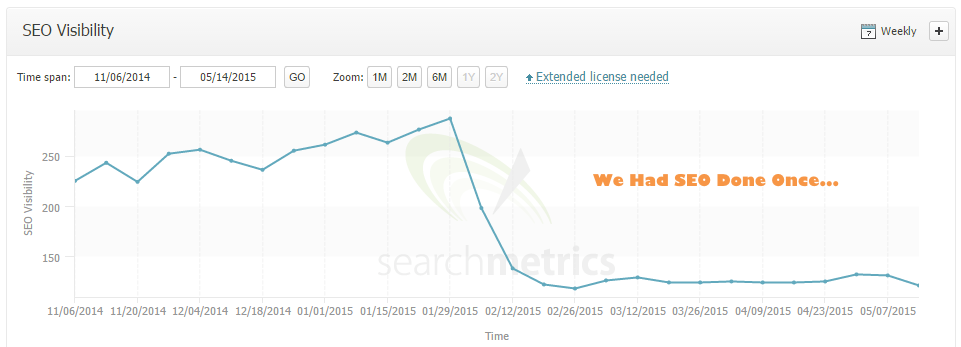
Would you ever see your physical shop or office space as being “done”? Or would you empty the bins daily, clean the carpets, tidy the desks, bring in new customers, promote your shop as being open, walk your shop floor daily, add new products to your inventory, run special offers and promotions to generate new customers and more? It is no different when looking online. The only difference comes down to choice. Each individual business either choses to invest in digital, or they don’t. Living in a digital world, you yourself will naturally research many of the products you have around you right now online in the first instance.
We Already Have a Website, Why Do We Need Another?
Is your website performing? No? Is your website mobile friendly? No? Does your website look like it was built in 1996? Yes? Your customers online are looking for a website that sells a specific product or service, is extremely easy to use, is branded very well and fits with their personal beliefs. If you website was built by your friends neighbour’s son who was taking a Dreamweaver course 10 years ago then it probably isn’t going to be relevant for your customers.
A bad website is like turning up trying to sell to potential customers unwashed, unshaven, wearing unfitted clothes with holes in and smelling like a wet dog. If you turned up in person to sell to potential customers like this, how do you think they would react? And how is this different online?
Your website is your digital shop front, make it count and engage with your audience. Website visitors want to see that you care, that you are there to help them accomplish their goal, that you are only a phone call away from being able to answer their queries and that you actually want new customers. A bad website simply pushes people away.
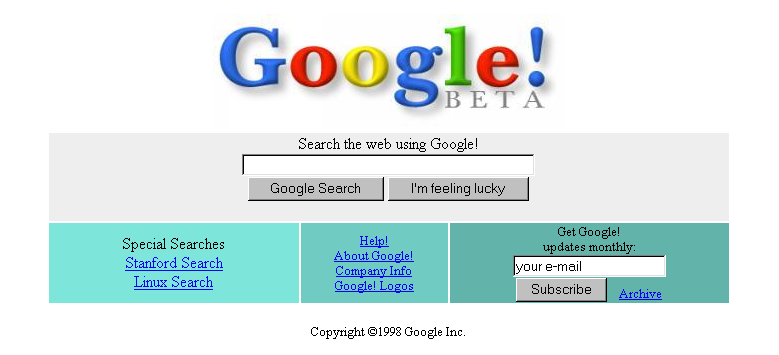
A good website builds loyal customers over time. Your website may not look as bad as Google’s did back in 1998 (although we have seen some that do come close!). Do you think Google would be as popular today if they didn’t invest in their website seriously over the past several years?
We Spent 10’s of Thousands on Our Website about 5 years
5 year is a lifetime in the digital world. Traditional civil engineering projects are often designed to last 100 years. You’re lucky if your website lasts 100 months without any input. Unfortunately spending money on digital projects does not guarantee quality. We’ve seen so many instances where companies have spent a lot of money on websites which simply haven’t delivered. Only recently have we seen a brand new website launched that is effectively telling Google to go away.
This is an unfortunate reality for many businesses, which is why we launched our Digital Lifeline packages so you can call on someone to give you solid advice about your digital activities and website technologies. Having bought a website years ago and wondering why this isn’t performing now is a little mad when you compare this to the real world. Imagine if you bought an old car from a sleazy second hand car sales man, you can picture the type, and then you decided not to get an MOT done at all, no services, any repairs were done with your own hammer, screwdriver, car manual and a bit of duck-tape where needed. How do you think your car would be performing today? Probably not very well.
Again, the same is true for your website. If you see your website as a cost, then you have already lost. If you see your website as a vehicle to increase ecommerce sales, enquiries from around the globe and ultimately revenue then you are on the right track. Imagine living out in the sticks, with only a post office and a corner shop in the village. Not a great deal of job opportunities (i.e. personal revenue). In this instance, buying a car isn’t a cost, buying a car gives you freedom to break into new markets such as cities and increase your personal revenue by getting a higher paid job. Your website is no different – when you invest in your website seriously.

Your Website Should Generate a Return on Your Investment
Have a think about this;
- If I asked you to give me a £1 coin right now, how many of you would pop one in the post to us? No-one? Why? We’re a great bunch of folk 🙂
- As a comparison, if I asked you to give me a £1 coin right now, and I would give you £2 back, how many £1 coins would you send us in the post? I’m guessing that you’d empty your bank account, right? Because you would double your money overnight.
The logic of investing in digital marketing channels is no different. The difference being between traditional marketing channels and digital marketing channels is that you can track every single detail in one of these channels, whereas you can track very little results in the other channel.
Looking at the famous quote;
“Half the money I spend on advertising is wasted; the trouble is I don’t know which half.”
I’d like to expand on this quote and be a tad facetious;
“Half the money I spend on advertising is wasted; It’s the offline half!”
Being able to track and understand how all of your marketing channels are performing will allow you to make strategic decisions to grow your business. Simply spending money aimlessly on activities that you’ve always done in business probably isn’t the best approach going forward, unless you are confident that this is already working for you.
Next Steps
We work with businesses of all shapes and sizes, some who are well versed in digital technologies and are needing support along their fast paced journey, and also companies who require a good amount of support as they are still at the start of digital journey. We will work with any business who requires our help and is ready.
The familiar quotes couldn’t be truer;
“You can lead a horse to water, but you can’t make it drink” – Quote
“When the student is ready, the teacher will appear” – Chinese proverb
“A journey of 1000 miles begins with a single step” – Chinese proverb
We’re ready to work with you and your company as soon as you are. All of the contents of this blog post are choices which people and businesses can make. People either choose to do something about their underperforming website and talk to us, or they choose to do what they have always done.
The more companies I personally speak with, the more I realise that success in the digital world is not down to our amazing work alone (although this does help!) but it is often down to the choices made by the individuals within either ambitious or struggling businesses.
Remember, all you need to do is ask we we’ll be there to help.

by Michael Cropper | May 13, 2015 | Thoughts |
Seriously, have we reached full capacity? I’m speaking specifically about traditional broadband connections, not fibre broadband. The ‘old’ broadband running on the copper lines from the exchange. It seems that this technology is well and truly full, at least based on personal experience and that of anecdotal evidence from speaking with other people in a similar situation.
To put this into context, previously the internet connection at home has been more than adequate for a good number of years based on the type of activities within the household. More recently, since our old provider was bought out by a larger provider and my personal working habits have changed slightly, I am starting to question if the current broadband infrastructure has reached full capacity and I’m putting the question out there, have you noticed any difference recently in your home non-superfast internet speeds?
Superfast Internet
The rollout of superfast broadband throughout the UK is absolutely needed, but have we gone far enough with the rollout? The current superfast broadband rollout is what is technically known as Fibre to the Cabinet, FTTC for short. In lay-person speak, this means that there is now a fibre connection from your local telephone exchange to the little green box at the end of your street.
Traditionally, this part of the journey was powered using copper wire. This is a problem due to the laws of physics. Transferring data (i.e. your internet connection) is significantly faster through a fibre optic cable than through the old copper wires. Hence why the rollout of fibre broadband was essential as data usage has significantly increased over recent years with the growth of services such as Netflix, YouTube, Amazon Prime, Tesco Blink, Xbox Live, Online Gaming and more.
But I question whether we have gone far enough with the upgrades and whether we actually have a long term solution in place for the growing data requirements for home and business users. The current superfast broadband rollout is a significant improvement which has implemented the improvements to part of the line as can be seen below;

Source: http://www.thinkbroadband.com/guide/fibre-broadband.html
What you will notice is that this isn’t the whole picture. There is part of the connection which is still using the older technology, which is the part of the connection between your green box and your home. For office use, this generally is not a problem as there is either a leased line to the premises or similar technology making the internet connection truly superfast. For some users, and most importantly, the growing remote and flexible workers as part of your workforce, this is actually a large problem. Personally, there is rarely a working day that is the same, with work being completed in various locations depending on the plan for the week. Which means that for myself personally, I could be experiencing internet connections with down streams nearing 100 mb/s or as poor as 2mb/s with continuous dropouts depending on the time of the day. While this doesn’t interrupt any activities, it does require a little more planning, a backup plan in place at all times in the form of mobile data, oh, and the forced upgrade to a fibre connection – more on that later though.
Speaking based only on anecdotal evidence, on a traditional broadband connection at home, the evidence is clear, broadband connectivity issues starting around 3:30pm, peaking around 5pm, starting to tailor off around 7pm. What I’m talking about here is when the internet connectivity gets so bad that it is not possible to load a website or connect to the internet. After a lot of thought on the topic, the only conclusion that I can make based on this is that children are arriving home from school at around 3:30pm, accessing all of the on-demand services, clogging up the internet then going to bed around 7pm. Thinking through many options that could be causing this, along with endless discussions with home broadband technical departments working to ‘resolve the issue’ (and failing miserably), it is clear that the old provider was not able to fix the issue which I believe to be related to the capacity crunch that we are all experiencing invisibly at the minute.
The Capacity Crunch
The next step of my personal story is that we are moving to superfast fibre broadband at home, not out of a want for faster speeds as for home use, traditional broadband used to be absolutely fine for our needs as a home user. No, we are moving to a superfast fibre connection out of necessity. As part of the process, one comment from the new supplier struck a cord and made me think about what has actually happened with the recent broadband rollout project within the UK. The comment was that the new provider is going to have to send out an engineer to the green box and flick us on to fibre.
So in summary, unless you are paying directly for a fibre connection, you simply aren’t benefiting from this new technology. Call me a cynic, but this does seem a little strange why home users aren’t automatically switched over to this upgrade when they already often paying reasonably hefty prices for basic usage, on the whole – and that the project was part funded (50/50) by the European Union through the European Regional Development Fund and local authorities throughout the UK.
The question I came to ask myself was whether we, as home consumers, were being forced down a paid upgrade route when the reality is that the current service being provided simply isn’t up to scratch and is not fit for purpose. The copper pipe is already full which is causing service issues for those people using traditional broadband technology.
Another topic in this area, which we will cover in more depth in another blog post is the difference between broadcast technology (i.e. your live TV) VS streaming technology (i.e. anything over the internet). We’ll look at the technical details a little more another time, for now, the key point is that broadband technology is a first-come-first-serve basis, meaning that if there is a certain amount of capacity on the old copper lines, then whoever uses the capacity first wins and those who aren’t quick enough lose out. All of this is clearly a little more complex than this in the background and simply put, those closer to the exchange have priority over the bandwidth. Meaning that the further away from your local exchange you are, the further down the pecking order you are when it comes to getting your fair share of bandwidth and often those further out are left with the crumbs at the end.
It may be no surprise to you based on the tone of this blog post that we aren’t quite sat next to the local exchange at home. Never the less, we also aren’t tens of miles away either. Traditional broadband has been (up until recently) and should be absolutely fine for our needs, yet it isn’t. Instead, a forced ‘upgrade’ to a fibre service is required to maintain basic connectivity to the home, not to get 200x the speed we currently get.
The Cloud
Putting this into context from a business perspective as a whole, more and more staff are requesting home and flexible working options for various reasons. The image I came across on LinkedIn recently resonated with a lot of people and really does go to show where business and the idea of ‘work’ is heading;
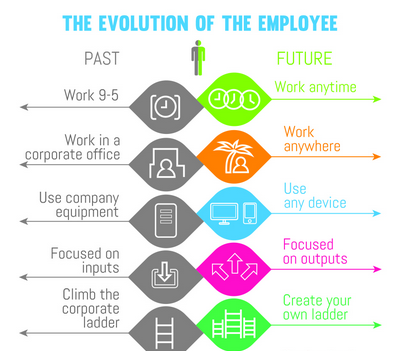
Attribution required: If this is your image, get in touch and we’ll credit you accordingly J
The concept of a modern day working environment requires an unbelievable robust internet connection throughout the UK that can be enjoyed by all. One that I do not believe we have. The recent upgrades are a step in the right direction but we need more.
As more businesses migrate their entire business to the cloud for all of the benefits this brings, the key to all of this working seamlessly is a robust internet network. With accounting software, project management software, research tools, file storage systems, customer relationship management systems and more all being contained within the cloud. This all only works with a fantastic internet connection throughout all parts of the data journey.
The Reality for Many
While this blog post may seem like a little rant against poor performing internet speeds at home, it isn’t. I’ve had that spat directly with the current provider on Twitter J No, this blog post is to highlight the issue that many people are currently experiencing yet there seems to be no real long term solution to this growing problem. Sure, we have had a significant improvement in the form of fibre broadband throughout the UK, but this is not going to last and quite frankly this rollout is not the inclusive Britain that we all aim to strive for. The ever increasing costs related to basic services, and I do include internet in this category, needs addressing and a real solution needs to be identified.
Browse through the swarms of people on Twitter complaining every day about broadband connection speed problems from all suppliers à https://twitter.com/search?f=realtime&q=slow%20broadband&src=typd. Backing up personal anecdotal evidence. This isn’t just the reality for a small number of people, this is a problem impacting an awful lot more people than those just voicing their opinions on Twitter.
Again, putting this into perspective, when comparing home broadband speeds directly with data speeds when connecting to the internet via a mobile phone provider, it is clear there is an issue with the technology;
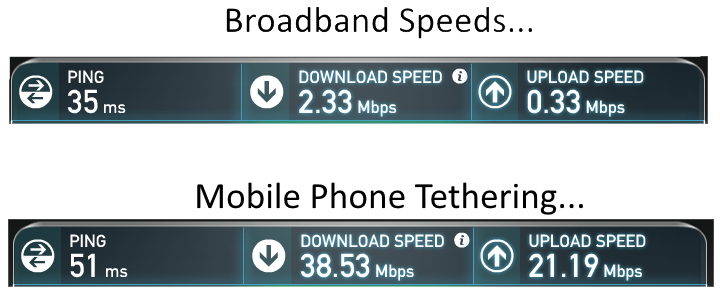
The mobile data tariffs are just way too expensive currently to warrant permanent connectivity through mobile phone networks. Although maybe this is a longer term solution and the reason why BT is looking to buy EE for £12.5 billion, the largest and fastest mobile network throughout the UK.
The Future
So where do we go from here? Clearly this is a problem where the solution is a little more involved than my thoughts in a blog post. With some interesting blog posts coming from BT on the matter recently, the issue is clearly already under discussion;
“BT’s head of optical access, Professor Andrew Lord, who will take part in the conference said: “It’s the first time we have had to worry about optical fibres actually filling up. We could expand the network by laying more cables but the economics of that do not work and it would increase power consumption. Prof Lord added that a possible solution to the problem would be to ration internet access, where household consumers and businesses would be charged for the amount of data they use.” – Source (5th May 2015)
“The internet will not need to be rationed in the future because of a “data capacity crunch”, according to a leading scientist from telecoms giant BT.” – Source (11th May 2015)
Whatever the solution, it is clear that more needs to be done by all the key players in this market to address these issues, and fast. Many web services are seeing exponential growth in data usage as consumer behaviour shifts from broadcast to on-demand services which is only going to grow further. Couple this with the future horizon in an internet connected world with the Internet of Things, we have a serious crunch approaching in my opinion.
This is purely my personal opinion on where we are at currently and where we are heading. It would be great to hear your thoughts on the topic and share your experience in the comments. Do you think the internet has reached full capacity? Do you think we are heading for a capacity crunch? Or are you simply loving your new fibre broadband speeds streaming series after series of the latest dramas on Netflix?
by Michael Cropper | Jun 14, 2011 | Thoughts |
With all of the changes and announcements from Google recently it appears they are heading in a completely different direction than their core business, search. Since Google began, it has always been about providing the best results to the users via their SERPs. They tried to give the user the choice of 10 organic (give or take) results based on a complex algorithm of hundreds of signals. They even wanted webmasters to get involved by making content more ‘readable’ to Google, which I guess is why the SEO industry was born.

Recently though Google seem to be steering away from this and thinking ‘Google knows best’. They now seem to be heading towards providing users choices based not on their normal SERPs, but choices via their own Google products. This is a very worrying direction since once they create a product and effectively force users to use this by prominently positioning it in the SERPs then this flushes all competition down the drain.
Lets take a look at a few of the recent developments from Google.
Google Advisor
Google Advisor which is a financial comparison tool comparing mortgages, credit cards and savings accounts.

This seems like a direct attack on the financial services industry and more importantly the rise of the recent price comparison monster websites. Should Google really be providing the same service as price comparison websites here? I don’t believe so as this is no longer about providing the ‘right’ results to the user, it is about pricing the competitors out of the market. Since Google doesn’t (at the moment) take any commissions on these products being offered, this could push out the price comparison websites who do take a commission – especially if Google begin to prioritise their own products in the SERPs.
Google Flight Comparison
Google Flight Comparison in the SERPs is Google’s latest brainwave which shows flight comparison information to ‘make it easier for users to understand’.

Seems like a good idea at first, and I know first hand that flight websites are some of the most confusing when coming to make a purchase. But looking at this closer, you can see that all of the comparison websites are now further down the listings in favour of Google’s own products! When did it become Google’s job to make things like this easier? Surely this is the job of the actual flight comparison websites and the flight companies their self, since they do have enough incentive to do this….better usability equals more sales.
Google Local
Now we get on to Google Local which includes the 7-pak results and the local listings mingled in within the SERPs. If we take a look at the listings shown for the search term “Manchester Hotels” then we can see thateverything above the fold is either sponsored listings or Google’s own products.
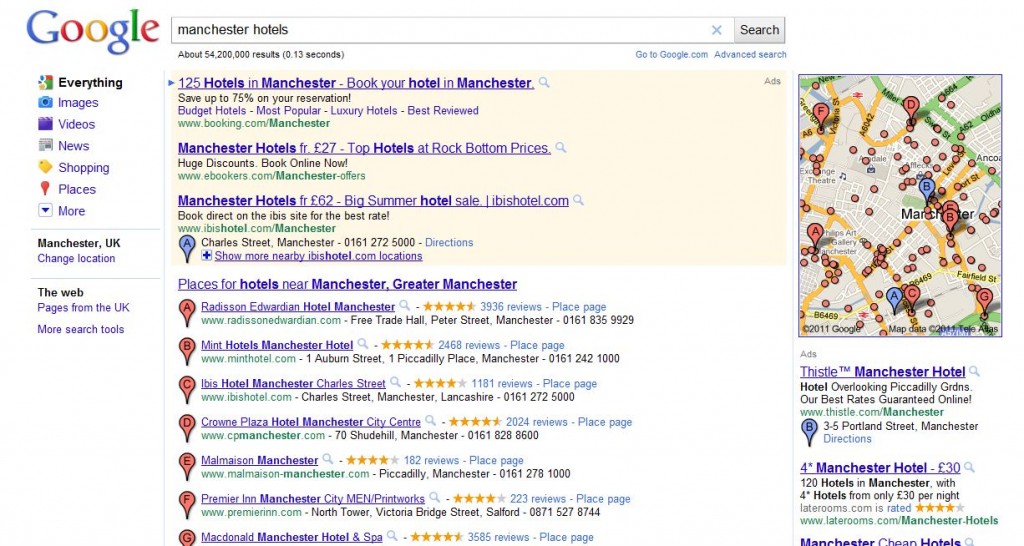
But wait, Google recently said that we should be focusing on quality content, making our websites the top source of information within the industry. And quoting the guidelines from Google directly
“Does this article have an excessive amount of ads that distract from or interfere with the main content?”
Is Google ignoring its own guidelines again…..? This whole scenario is causing lost business for the smaller companies who cannot afford the sponsored listings and lets be fair, the Google Places listings are more of a bonus than a real listing.
Google Mobile Wallet
Next we are looking at the latest Google Mobile Wallet which is offering a Paypal style payment system which is via your mobile phone, the only difference being is that Google Mobile Wallet is free! Does this mean that people will slowly move away from Paypal or maybe even moving further away from traditional credit cards?

This would no doubt all link in nicely with the Google Advisor tool mentioned above within the next few years.
Google Offers
Google’s latest product is Google Offers which seems to be attacking Groupon and other offer websites. Quite fitting really since in the latest algorithm update by Google, Panda, was actually attacking websites like this!
 This seems like the good old business plan behind Tesco in the UK. Build lots of large retail outlets and offer cut price goods which forces all of the smaller retailers out of business. Then once all of the smaller retailers are forced out of business because they cannot compete in the market, Tesco opens up some Tesco Express stores to fill the new gap in the market and totally dominating the market place.
This seems like the good old business plan behind Tesco in the UK. Build lots of large retail outlets and offer cut price goods which forces all of the smaller retailers out of business. Then once all of the smaller retailers are forced out of business because they cannot compete in the market, Tesco opens up some Tesco Express stores to fill the new gap in the market and totally dominating the market place.
Conclusion
It is certainly interesting looking at all of these new developments from Google and how they may all link together. Google already dominate a massive market and it seems they are going after everyone else now too….
Watch this space…
by Michael Cropper | May 14, 2011 | Thoughts |
As some of you may have noticed the new search results Google is testing today. Whether you love or hate them, doesn’t really matter – Google is doing it and we have to adapt if they do roll this out for everyone at a later date. Below is a search for the phrase London Hotelson Google.co.uk which shows the new layout.

Now these results alone are not the main issue for me, it is how they have also expanded the width of their sponsored results too. Which means that there are now no organic results at all above the fold of the page with my screen resolution set as 1366 x 768.
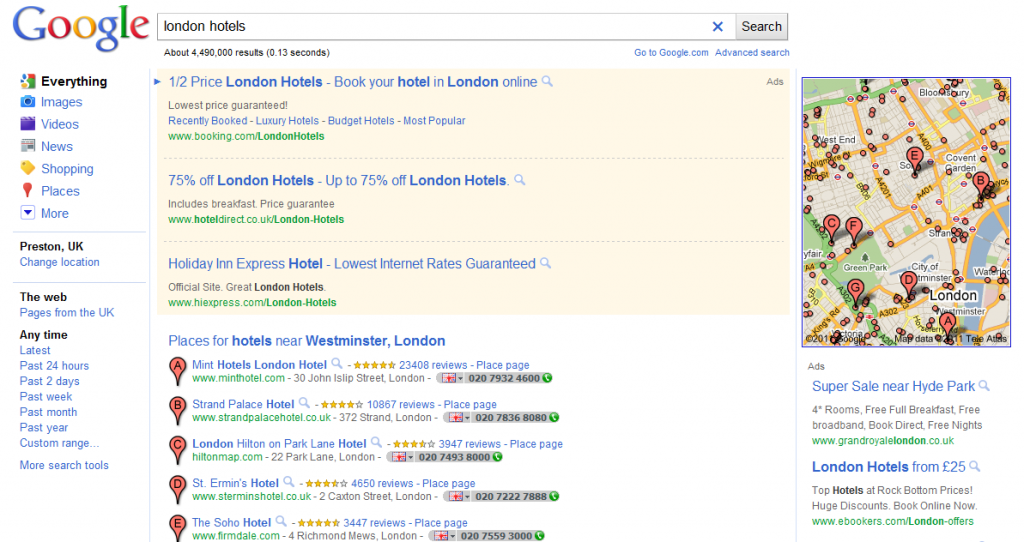
Baidu is China’s main search engine with around a 67% market share (Google has around 16% in China). Baidu has no shame in admitting they are wanting as much money as possible from adverts which is why up to 80% of Baidu’s SERPs can be either paid/sponsored listings or Baidu’s own services (such as its own versions of Wiki, Yahoo Q&A, Forums etc)
When you look at the Baidu search results for the phrase “Beijing Hotels” in Simplified Chinese, you will also notice that there are absolutely no organic listings above the fold too.

Is Google putting more weight towards the financial gains within markets where they totally dominate? It would certainly make sense, since there is a finite amount of searches that happen daily and if they dominate the search engine market within a certain country then they may as well get more money from these queries.
Although, what happened to all that “its all about the user”? I am not convinced seeing less results above the fold is better for the user. I like choice, I want to see a selection of results which I can choose based on what I am really looking for, not what Google thinks I am looking for.























Google needs to be broken up. They have too much power. I intend to request any and all U S government documents involving Google under the Freedom of Information Act and see what I can find. I think Google may be guilty of fraud in their use of Moffett Field to house their fleet of private jets. I have won about 30 Freedom of Information Act cases against the federal government. They may owe hundreds of millions if not billions in damages.
Sounds exciting Lloyd, do keep me posted